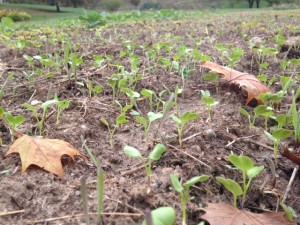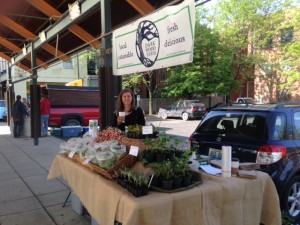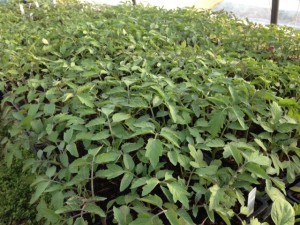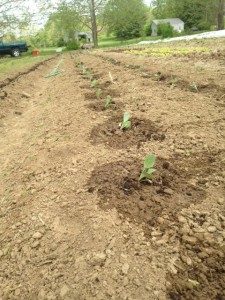
Clover and Austrian Winter Peas are cold hardy legumes, plants that can take nitrogen from the air and fix it into the soil where it can act as a fertilizer. These plants will vine and spread to cover the surface of the ground. In the spring, they will make beautiful blossoms that will attract pollinators to the garden, and the tender tips of the pea plants can be eaten in salads or used in stir fry. Tillage radishes and brown-seeded mustard are both in the Brassica plant family and serve different purposes. Tillage radishes make long, skinny roots which will rot away in the spring and thereby help break up soil compaction and allow air and water percolation through the soil. The brown-seeded mustard plants will make edible greens in the spring, but they will also send up large stalks that will provide vertical structure for the peas to climb. The seed from these plants can be harvested to made spicy brown mustard! Winter rye is the most cold tolerant plant in my cover crop mix, and even if we get another frigid winter this year, it will survive and grow again in the spring to provide lots of biomass that will be cut down and added back to the soil. Over the winter, its deep roots will keep the soil in place. Buckwheat is a plant that is often grown as a summer cover crop because it grows rapidly in the heat and is quite sensitive to cold and frost. I had some buckwheat seed laying around and I sowed it in with my fall cover crops. I know it will die back soon, maybe even tonight with our first freeze, but in the meantime it has grown quickly and is no doubt helping keep the soil in place. It will die off just as the cool-loving crops want more space to spread out. Finally, there are a lot of volunteer cover crops doing their work out in the garden. Some people might call these plants weeds, but I look at them as a free cover crop. Mostly I see henbit or purple dead nettle (I have a hard time telling them apart when they’re little) just starting to leaf out. These are low-growing plants that will act as nurse crops, filling in the spaces between the intentional cover crops. What I’m hoping for this winter is a lush, green carpet to cover the bare soil. In the spring, I look for the green carpet to give rise to a beautiful stand of plants with low growing vines, lots of vertical structure, and flowers aplenty. At the moment, our green cover crop carpet is well underway, and with the rain we have been receiving for the past week, it is glowing and growing before my eyes. These plants are happy to be out in the cool weather and are saying, “bring it on!” to the winter. So am I.




